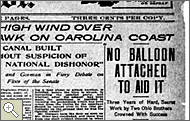
The Norfolk Virginian-Pilot, December 18, 1903
The problem of aerial navigation without the use of a balloon has been solved at last.
Over the sand hills of the North Carolina coast yesterday, near Kitty Hawk, two Ohio men proved that they could soar through the air in a flying machine of their own construction, with the power to steer it and speed it at will. This, too, in the face of a wind blowing at the confirmed velocity of twenty-one miles an hour.
Like a monster bird, the invention hovered above the breakers and circled over the rolling sand hills at the command of its navigator and, after soaring for three miles, it gracefully descended to earth again and rested lightly upon the spot selected by the man in the car as a suitable landing place.
While the United States government has been spending thousands of dollars in an effort to make practicable the ideas of Professor Langley of the Smithsonian Institute, Wilbur and Orville Wright, two brothers, natives of Dayton, O., have quietly, even secretly, perfected their invention, and put it to a successful test.
They are not yet ready that the world should know the methods they have adopted in conquering the air, but the Virginian-Pilot is able to state authentically the nature of their invention, its principle and its chief dimensions.
How the Machine Was Built
The idea of the box kite has been adhered to strictly in the basic formation of the flying machine.
A huge framework of light timbers, 33 feet wide, five feet deep and five feet across the top forms the machine proper.
This is covered with a tough, but light canvas.
In the center, and suspended just below the bottom plane is the small gasoline engine which furnishes the motive power for the propelling and elevating wheels
There are two six-bladed propellers, one arranged just below the center of the frame, so gauged as to exert an upward force when in motion, and the other extends horizontally to the rear from the center of the car, furnishing the forward impetus.
Protruding from the center of the car is a huge fan-shaped rudder of canvass, stretch upon a frame of wood. This rudder is controlled by the navigator and may be moved to each side, raised or lowered.
Start Was Success
Wilbur Wright, the chief inventor of the machine, sat in the operator’s car and when all was ready his brother unfastened the catch which held the invention at the top of the slope.
The big box began to move slowly at first, acquiring velocity as it went, and when half way down the hundred feet the engine was started.
The propeller in the rear immediately began to revolve at a high rate of speed, and when the end of the incline was reached the machine shot out into space without a perceptible fall.
By this time the elevating propeller was also in motion, and, keeping its altitude, the machine slowly began to go higher and higher until it finally soared sixty feet above the ground.
Maintaining this height by the action of the under wheel, the navigator increased the revolutions of the rear propeller, and the forward speed of the huge affair increased until a velocity of eight miles an hour was attained.
All this time the machine headed into a twenty-one mile wind.
Coast Folk Amazed
The little crowd of fisher folk and coast guards, who have been watching the construction of the machine with unconcerned curiosity since September 1st, were amazed.
They endeavored to race over the sand and keep up with the thing of the air, but it soon distanced them and continued its flight alone, save the man in the car.
Steadily it pursued its way, first tacking to port, then to starboard, and then driving straight ahead.
“It is a success,” declared Orville Wright to the crowd on the beach after the first mile had been covered.
But the inventor waited. Not until he had accomplished three miles, putting the machine through all sorts of maneuvers en route, was he satisfied.
Then he selected a suitable place to land, and, gracefully circling, drew his invention slowly to the earth, where it settled, like some big bird, in the chosen spot.
“Eureka,” he cried, as did the alchemist of old.
|
 |
 |
 |
 |

The News
|
 |
 |

The Norfolk Virginian-Pilot, December 18, 1903
|
 |
 |
 |
|

